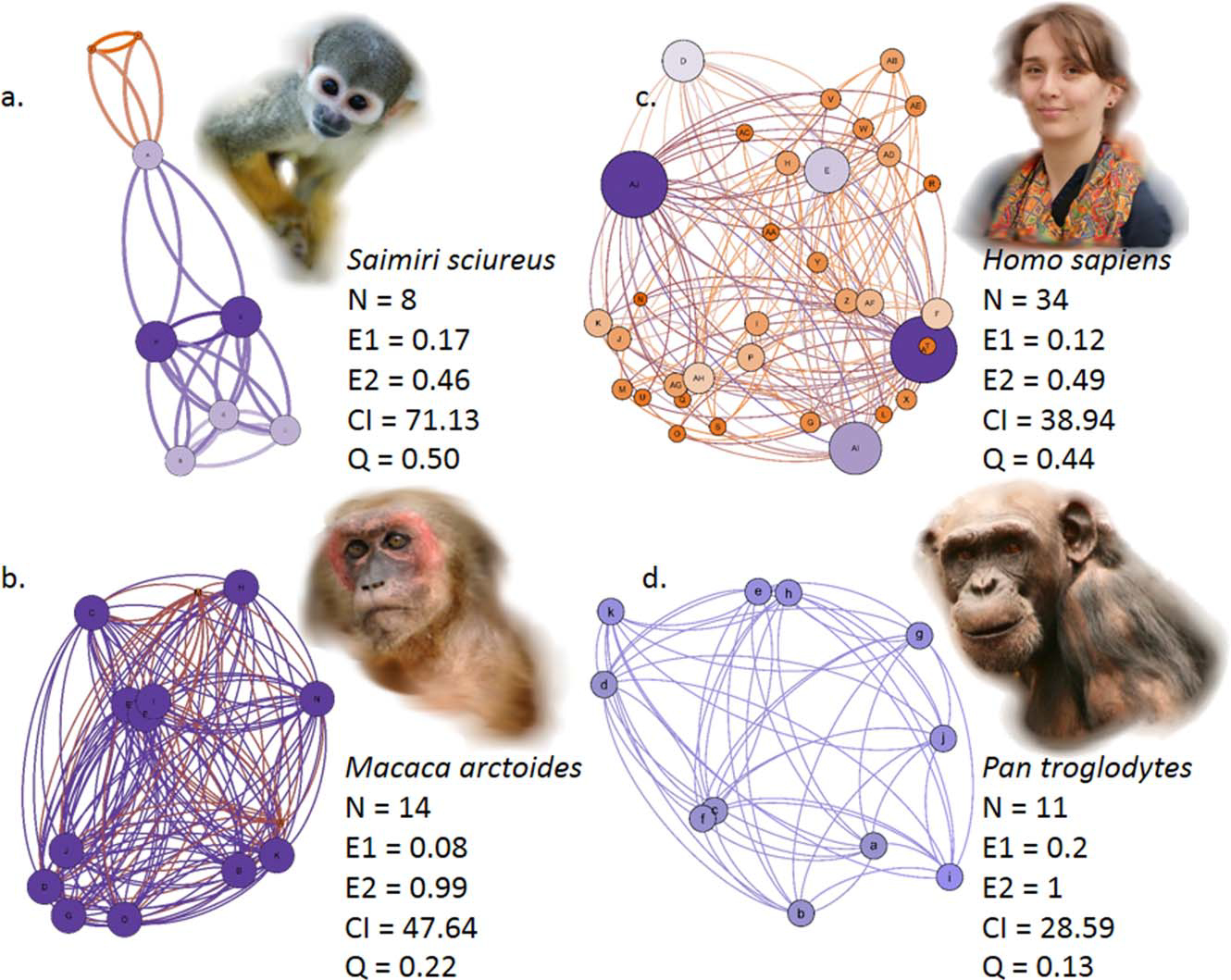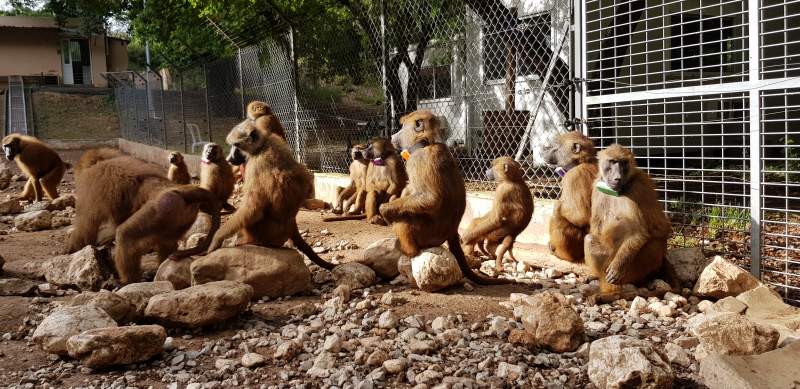Anointing is a behaviour in which animals apply pungent-smelling materials over their bodies. It can be done individually or socially in contact with others. Social anointing can provide coverage of body parts inaccessible to the individual, consistent with hypotheses that propose medicinal benefits. However, in highly social capuchin monkeys, Sapajus and Cebus spp., anointing has been suggested to also benefit group members through ‘social bonding’. To test this, we used social network analysis to measure changes in proximity patterns during and shortly after anointing compared to a baseline condition. We presented two capuchin groups with varying quantities of onion, which reliably induces anointing, to create ‘rare resource’ and ‘abundant resource’ conditions. We examined the immediate and overall effects of anointing behaviour on the monkeys’ social networks, using patterns of proximity as a measure of social bonds. For one group, proximity increased significantly after anointing over baseline values for both rare and abundant resource conditions, but for the other group proximity only increased following the rare resource condition, suggesting a role in mediating social relationships. Social interactions were affected differently in the two groups, reflecting the complex nature of capuchin social organization. Although peripheral males anointed in proximity to other group members, the weak centrality only changed in one group following anointing bouts, indicating variable social responses to anointing. We suggest in part that anointing in capuchins is analogous to social grooming: both behaviours have an antiparasitic function and can be done individually or socially requiring contact between two or more individuals. We propose that they have evolved a social function within complex repertoires of social behaviours. Our alternative perspective avoids treating medicinal and social explanations as alternative hypotheses and, along with increasing support for the medical explanations for anointing, allows us to conceptualize social anointing in capuchins as ‘social medication’.
Category: Social network
From temporal network data to the dynamics of social relationships
Abstract: Networks are well-established representations of social systems, and temporal networks are widely used to study their dynamics. However, going from temporal network data (i.e. a stream of interactions between individuals) to a representation of the social group’s evolution remains a challenge. Indeed, the temporal network at any specific time contains only the interactions taking place at that time and aggregating on successive time-windows also has important limitations. Here, we present a new framework to study the dynamic evolution of social networks based on the idea that social relationships are interdependent: as the time we can invest in social relationships is limited, reinforcing a relationship with someone is done at the expense of our relationships with others. We implement this interdependence in a parsimonious two-parameter model and apply it to several human and non-human primates’ datasets to demonstrate that this model detects even small and short perturbations of the networks that cannot be detected using the standard technique of successive aggregated networks. Our model solves a long-standing problem by providing a simple and natural way to describe the dynamic evolution of social networks, with far-reaching consequences for the study of social networks and social evolution.
Measuring social networks in primates: wearable sensors versus direct observations
Abstract: Network analysis represents a valuable and flexible framework to understand the structure of individual interactions at the population level in animal societies. The versatility of network representations is moreover suited to different types of datasets describing these interactions. However, depending on the data collection method, different pictures of the social bonds between individuals could a priori emerge.
Understanding how the data collection method influences the description of the social structure of a group is thus essential to assess the reliability of social studies based on different types of data. This is however rarely feasible, especially for animal groups, where data collection is often challenging.
Here, we address this issue by comparing datasets of interactions between primates collected through two different methods: behavioural observations and wearable proximity sensors. We show that, although many directly observed interactions are not detected by the sensors, the global pictures obtained when aggregating the data to build interaction networks turn out to be remarkably similar. Moreover, sensor data yield a reliable social network over short time scales and can be used for long-term studies, showing their important potential for detailed studies of the evolution of animal social groups.
Detecting social (in) stability in primates from their temporal co-presence network
Abstract: The stability of social relationships is important to animals living in groups, and social network analysis provides a powerful tool to help characterize and understand their (in)stability and the consequences at the group level. However, the use of dynamic social networks is still limited in this context because it requires long-term social data and new analytical tools. Here, we studied the dynamic evolution of a group of 29 Guinea baboons, Papio papio, using a data set of automatically collected cognitive tests comprising more than 16 million records collected over 3 years. We first built a monthly aggregated temporal network describing the baboon’s co-presence in the cognitive testing booths. We then used a null model, considering the heterogeneity in the baboons’ activity, to define both positive (association) and negative (avoidance) monthly networks. We tested social balance theory by combining these positive and negative social networks. The results showed that the networks were structurally balanced and that newly created edges also tended to preserve social balance. We then investigated several network metrics to gain insights into the individual level and group level social networks’ long-term temporal evolution. Interestingly, a measure of similarity between successive monthly networks was able to pinpoint periods of stability and instability and to show how some baboons’ ego-networks remained stable while others changed radically. Our study confirms the prediction of social balance theory but also shows that large fluctuations in the numbers of triads may limit its applicability to study the dynamic evolution of animal social networks. In contrast, the use of the similarity measure proved to be very versatile and sensitive in detecting relationships’ (in)stabilities at different levels. The changes we identified can be linked, at least in some cases, to females changing primary male, as observed in the wild.
Social networks from automated cognitive testing
Abstract: Social network analysis has become a prominent tool to study animal social life, and there is an increasing need to develop new systems to collect social information automatically, systematically, and reliably. Here we explore the use of a freely accessible Automated Learning Device for Monkeys (ALDM) to collect such social information on a group of 22
captive baboons (Papio papio). We compared the social network obtained from the co-presence of the baboons in ten ALDM testing booths to the social network obtained through standard behavioral observation techniques. The results show that the co-presence network accurately reflects the social organization of the group, and also indicate under which conditions the co-presence network is most informative. In particular, the best correlation between the two networks was obtained with a minimum of 40 days of computer records and for individuals with at least 500 records per day. We also show through random permutation tests that the observed correlations go beyond what would be observed by simple synchronous activity, to reflect a preferential choice of closely located
testing booths. The use of automatized cognitive testing therefore presents a new way of obtaining a large and regular amount of social information that is necessary to develop social network analysis. It also opens the possibility of studying dynamic changes in network structure with time and in relation to the cognitive performance of individuals.
Social networks in primates: smart and tolerant species have more efficient networks
 Pasquaretta, C., Leve, M., Claidiere, N., van de Waal, E., Whiten, A., MacIntosh, A. J. J., . . . Sueur, C. (2014). Social networks in primates: smart and tolerant species have more efficient networks. Sci. Rep., 4. doi: 10.1038/srep07600
Pasquaretta, C., Leve, M., Claidiere, N., van de Waal, E., Whiten, A., MacIntosh, A. J. J., . . . Sueur, C. (2014). Social networks in primates: smart and tolerant species have more efficient networks. Sci. Rep., 4. doi: 10.1038/srep07600
Diffusion Dynamics of Socially Learned Foraging Techniques in Squirrel Monkeys
Abstract: Social network analyses [1–5] and experimental studies of social learning [6–10] have each become important domains of animal behavior research in recent years yet have remained largely separate. Here we bring them together, providing the first demonstration of how social networks may shape the diffusion of socially learned foraging techniques [11]. One technique for opening an artificial fruit was seeded in the dominant male of a group of squirrel monkeys and an alternative technique in the dominant male of a second group. We show that the two techniques spread preferentially in the groups in which they were initially seeded and that this process was influenced by monkeys’ association patterns. Eigenvector centrality predicted both the speed with which an individual would first succeed in opening the artificial fruit and the probability that they would acquire the cultural variant seeded in their group. These findings demonstrate a positive role of social networks in determining how a new foraging technique diffuses through a population.
Network Analysis of Social Changes
Chimpanzees are highly territorial and have the potential to be extremely aggressive toward unfamiliar individuals. In the wild, transfer between groups is almost exclusively completed by nulliparous females, yet in captivity there is often a need to introduce and integrate a range of individuals, including adult males. We describe the process of successfully integrating two groups of chimpanzees, each containing 11 individuals, in the Budongo Trail facility at the Royal Zoological Society of Scotland’s Edinburgh Zoo. We use social network analysis to document changes in group dynamics within this population over the 16 months following integration. Aggression rates were low overall and members of the two original groups engaged in significantly fewer aggressive interactions over time. Association and grooming data indicate that relationships between members of the original groups became stronger and more affiliative with time. Despite these positive indicators the association data revealed the continued existence of two distinct subgroups, a year after integration. Our data show that when given complex space and freedom to exhibit natural fission–fusion groupings, in which the chimpanzees choose whom they wish to associate and interact with, the building of strong affiliative relationships with unfamiliar individuals is a very gradual process.

